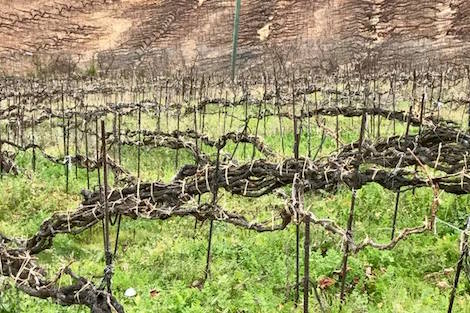Region: Valle de la Orotava, a valley in the north of the volcanic Island of Tenerife.
Grape: Mostly Listan Blanco with a blend of Gual, Marmajuelo, Baboso Blanco, Albillo Criollo, Vijariego Blanco and Verdello (indigenous varietals).
Vinification: 40% in concrete tanks with skins and 60% in stainless steel, followed by 8 months in concrete tanks and 8 months in old french oaks casks.

Tasting:
Wild canary island white, nothing like Tajinaste. Major minerality on the nose, smoky gunpowder and flinty rocks, somewhat like the Poema but with less lime and mint. This has a savoury marine quality. If there is fruit (there is very little), call it green apple on the palate. There is also a hint of oak on both the palate and nose but in a very restrained and integrated way. Like the slightest dusting of cacao powder.
Cordite-smoky with a strong pungency. Long and exciting, redolent of wild, windswept, lonely stretches of beach: seaweed-strewn, iodine and salt and rust and wet shells on the foam. Very direct. Determined and angular and striding out. It gave me goosebumps.”
– Jancis Robinson MW, jancisrobinson.com
Due to its isolation from continental Europe and the sandiness of the soils, most of the vines are ungrafted. Another unique feature is the training of the vines into braided cordons known as el cordon trenzado. This system made it easy to practice polyculture in within a vineyard so a farmer could harvest grapes and vegetables from the same plot.

What can we learn?
– Volcanic ash is porous, and it mixes with rocks, creating a hospitable environment for plants to absorb water through their roots. The lava flows fill the ashy soil with nutrients such as magnesium, calcium, sodium, iron, and potassium.
As such, not only are the soils of Tenerife and volcanic locales like it, such as Mount Etna in Sicily and Santorini in Greece, rich in minerals, but the vine has access to those minerals due to the porosity of the ash. These wines always bring non-fruit aromas and flavors to the fore, hence their endless intrigue.
The Valle do Orotova is located in the northern half of the island (Tenerife), in the shadow of the mountain El Teide, Spain’s highest peak. This creates a break that spares the southern half significant rainfall or cool winds and has kept the northern half cool and wet, mercifully free of marauding tourists looking for a full English breakfast. “We’re located in the north and due to the height of Tenerife our weather is very fresh we call it Atlantic” says Jonathan Garcia Lima, founder of the islands finest winery, Suertes de Marqués. “Our idea is to make wines that represent our place so it is important to show our volcanic terroir. We’re always looking for minerality.” His wine’s laser-like focus is the result of old, ungrafted vines that are grown at some of the highest altitudes in Europe, and is evident in both the reds and the mouth-watering whites… flint, gunsmoke and way more acidity than you’d expect from palomino (Listan Blanco’s better-known synonym, and Jerez’s most common grape.
– Noble Rot Magazine #11 Volcanic Island Wines.


